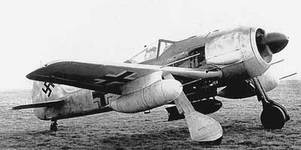Wulf-pack Disintegrates (Apr 2014)
From 1941 to 1944 the RAF challenged the Luftwaffe with a campaign of sweeps over Northern France. But the cross-Channel traffic was not entirely one-way. Although they were pre-occupied by the Russian campaign, the Luftwaffe retained a couple of squadrons of Focke-Wulf 190 fighter bombers to carry out attacks on English targets. There were many low-level raids on coastal towns by single, pairs and small groups of FWs. And on 31 October 1942, in the largest daylight raid since the Battle of Britain, no fewer than 60 Fws caused considerable damage and casualties in Canterbury.
RAF Typhoons and later mark Spitfires were an effective defence against the daylight raids and in April 1943, the Fws of Schnellkampfgeschwader 10 (SKG 10) were switched to night operations. On their first raid in the new role four fighter bombers set out to bomb London. Somehow, in the misty conditions and low on fuel, they got lost over Kent.
RAF Typhoons and later mark Spitfires were an effective defence against the daylight raids and in April 1943, the Fws of Schnellkampfgeschwader 10 (SKG 10) were switched to night operations. On their first raid in the new role four fighter bombers set out to bomb London. Somehow, in the misty conditions and low on fuel, they got lost over Kent.

At RAF West Malling, an aircraft was heard approaching the field. It was assumed to be a Defiant, still being used by the RAF as a night fighter. The airfield beacon and runway lights were switched on. The aircraft duly responded by firing a recognition signal and then it landed on the grass runway. The men of the duty crew, which included airfield defence soldiers of the 4th Light AA Regiment, were surprised to recognize the visitor as an Fw 190. As a gunner approached, the pilot, Feldwebel Otto Bechtold, raised his hands in surrender
Minutes later a second aircraft prepared to land. It was another Focke-Wulf but on touching down, the pilot suddenly realised his mistake and gave his engine full throttle. The gunners fired a burst from their Vickers gun and the fuel tank burst into flame. The pilot crawled out of the wreckage with his clothing on fire. The crew tried to stop him running away and there was a scuffle. The German pilot broke free, ran around the back of the tender and straight into the arms of the Station Commander, Wg Cdr Peter Townsend. Leutnant Fritz Setzer surrendered and was taken to the sick bay.
A third Fw then circled the airfield. The army crew manning the gun emplacements opened fire and the aircraft crashed at Springetts Farm, East Malling. Oberfeldwebel Otto Schulz was found by ambulance men having a drink with a local man. The pilot of the fourth aircraft of this ill-fated raid made no attempt to land and bailed out. Too low for his parachute to deploy Oberleutnant Kurt Khaln fell to his death. The crews at West Malling waited in some trepidation for an entire German squadron to appear in its circuit but it was not to be. No further aircraft was spotted and the runways lights were turned off at 2am.

Fw Otto Bechtold’s undamaged Fw A-4/U8, which was Yellow H of 7/SKG 10, was flown to Farnborough. It became PE 882 of the RAF’s 1426 (Enemy Aircraft) Flight, sometimes known as the Rafwaffe. It was extensively flown for evaluation and finally was destroyed in a crash on 13 October 1944.